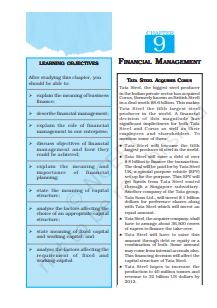‘Financial Management NCERT Solutions for Class 12 Business Studies Chapter 9‘ PDF Quick download link is given at the bottom of this article. You can see the PDF demo, size of the PDF, page numbers, and direct download Free PDF of ‘Ncert Class 12 Business Studies Chapter 9 Exercise Solution’ using the download button.
Financial Management NCERT Textbook With Solutions PDF Free Download

Chapter 9: Financial Management
In the above case, these decisions require careful financial planning, an understanding of the resultant capital structure, and the riskiness and profitability of the enterprise.
All these have a bearing on shareholders as well as employees.
They require an understanding of business finance, major financial decision areas, financial risk, and working capital requirements of the business.
Finance, as we all know, is essential for running a business. The success of the business depends on how well finance is invested in assets and operations and how timely and cheaply the finances are arranged, from outside or from within the business.
Money required for carrying out business activities is called business finance. Almost all business activities require some finance.
Finance is needed to establish a business, run it, modernize it, expand, or diversify it.
It is required for buying a variety of assets, which may be tangible like machinery, factories, buildings, or offices; or intangible such as trademarks, patents, technical expertise, etc.
Also, finance is central to running the day-to-day operations of the business, like buying materials, paying bills, salaries, collecting cash from customers, etc. needed at every stage in the life of a business entity.
Availability of adequate finance is, thus, very crucial for the survival and growth of a business.
All finance comes at some cost. It is quite imperative that it needs to be carefully managed. Financial Management is concerned with optimal procurement as well as the usage of
finance.
For optimal procurement, different available sources of finance are identified and compared in terms of their costs and associated risks.
Similarly, the finance so procured needs to be invested in a manner that the returns from the investment exceed the cost at which procurement has taken place.
| Author | NCERT |
| Language | English |
| No. of Pages | 30 |
| PDF Size | 365 KB |
| Category | Business Studies |
| Source/Credits | ncert.nic.in |
NCERT Solutions Class 12 Business Studies Chapter 9 Financial Management
Q1. What is financial risk? Why does it arise?
Financial risk is said to be the situation when a company is unable to meet its set of fixed expenses such as interest payment, loan repayment, and preference dividend pay-out. It is the situation where a company is unable to meet its financial obligations.
Financial risk arises due to a high level of debt in the capital structure. A high level of debt leads to a high amount of interest which increases the chances of defaulting on payment.
Q2. Define a ‘current asset’. Give four examples of such assets.
Current assets of a firm are those assets that have the potential to be converted into cash or cash equivalents within the current accounting period.
Current assets provide liquidity to the company. Examples of current assets are cash, short-term investment, marketable securities, and debtors.
Q3. What are the main objectives of financial management? Briefly explain
The main objective of financial management is the maximization of shareholders’ wealth. Therefore, financial management is all about making those decisions that will bring gains for the shareholders.
Gains can be said to be achieved when the market value of shares rises.
Once the primary objective of wealth maximization is achieved the other objectives such as maintaining liquidity and proper utilization of funds are fulfilled along with it.
Q4. Financial management is based on three broad financial decisions. What are these?
Financial management is the technique of proper allocation, acquisition, and use of funds by the company.
The three broad financial decisions on which financial management is based are investment decisions, financial decisions, and dividend decisions.
Q5. ”Capital structure decision is essentially optimization of risk-return relationship”. Comment.
Capital structure is the combination of debt and equity which is used by a company to finance its requirements for funds.
Debt can be obtained in the form of loans while equity is generated through retained earnings or common stock.
Borrowed funds can be in the form of loans, debentures, bank loans, etc. While in the case of the owner’s fund it can be in the form of preference share capital, reserves, retained earnings, equity share capital, etc.
Debt and equity both have their risk and profitability. Debt is a relatively cheap source while the greater risk is there and equity is comparatively expensive but is of lower risk for the firm.
Fundraising through debt is cheaper while the same with equity is expensive. Debt though cheaper is having more risks as it has an obligation toward lenders.
For equity, there is no such compulsion of paying dividends.
Also, the return offered by the sources leads to an increase in value per share. Debt gives higher returns per share but increases the risk comparatively many times.
Therefore, capital structure decisions should be taken into consideration with return and the amount of risk involved.
NCERT Class 12 Business Studies Textbook Chapter 9 With Answer PDF Free Download
